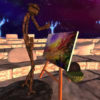More than a few of the world cultures have no word for religion. They actually use their word for law, and community cohesion revolved around the insights held by the priests. In some cultures artists and priests were allies where the spirit behind the cultures law nurtured the spirit of the artist. Then they sought to express their personal relationship to the world as they knew it in their community and as described by the members of their society.
In these cultures, the creation of images was generally not shunned. In other cultures, the artists were the first heretics. As communities grew and prospered, some cultures saw it as necessary to discourage any activity not encouraged by their law. That way all that strength and energy could be “properly” funneled into sustaining the interests of the community as defined by their religion. The basis of the two disciplines are intermeshed, but when they clash… Well, we have seen the results repeatedly.
So art and religion ran parallel with each other for a very long time. When religion became empire than we see the split between the arts in general and those arts we consider crafts. Chapel building was okay and building those necessary things for survival was okay, but building much else was frowned upon in those cultures though it continued anyway.
That’s why the ornate old buildings have so much religious symbolism? Yes, as well as the belief that these had power, and well, even recent research confirms that they did and do have power of a sort.
The religions were nervous that the art would inspire people to possibly go against the doctrine? Yes, and there are a great many documents attesting to that.
Now with the split between art and religion, you see the surfacing of a perhaps very strange art following a parallel path to that originally taken by religion. Religion looked at the physical world and tried to intuit deeper meaning in the ways of the world in order to understand the territory, issues of dominion and power. Sort of like understanding animal behavior serves to allow humans to avoid being eaten by a wolf. They sought to avoid running afoul of whatever was in charge of the world, but also to share in the strength and authority of that presence or presences. With the rise of religion, these powers or beings become part of the community also.
The strange art I spoke of was also arrived at intuitively. Some understood physical experience on a smaller scale, and while artists sought to understand, describe and explore this experience, this strange art sought to influence it through the same channel that human beings themselves were influenced. They began to form a body of insights into the way these influences seemed to behave, and the things they seemed responsible for creating or causing to happen, and they practiced reproducing these insights. A simple one being the intuition that animals behave at least somewhat like people so they could be communicated with, and even have their behavior changed by changing the situation around them. This served as a craft that they explored and expanded as much as they could, and when the arts and religion grew apart, these also became heretics as their body of insights often showed them that the world around them only partially reflected the law taught by and supported by the priests.
Is there an example of that kind of art? Perhaps the making of dolls and animal toys? Indeed, it did lead to the creation of dolls and animal toys, and influenced the creation of tools. We now know the art as magic.
I expect the art of alchemy was a big one shunned by religion. Ah, indeed it was. The idea that something other than god could spare your life, in time was seriously discouraged.
Your thoughts are welcome. Be well friends.
Travis Saunders
Dragon Intuitive
~science,mysticism,spirituality~



Leave a Reply